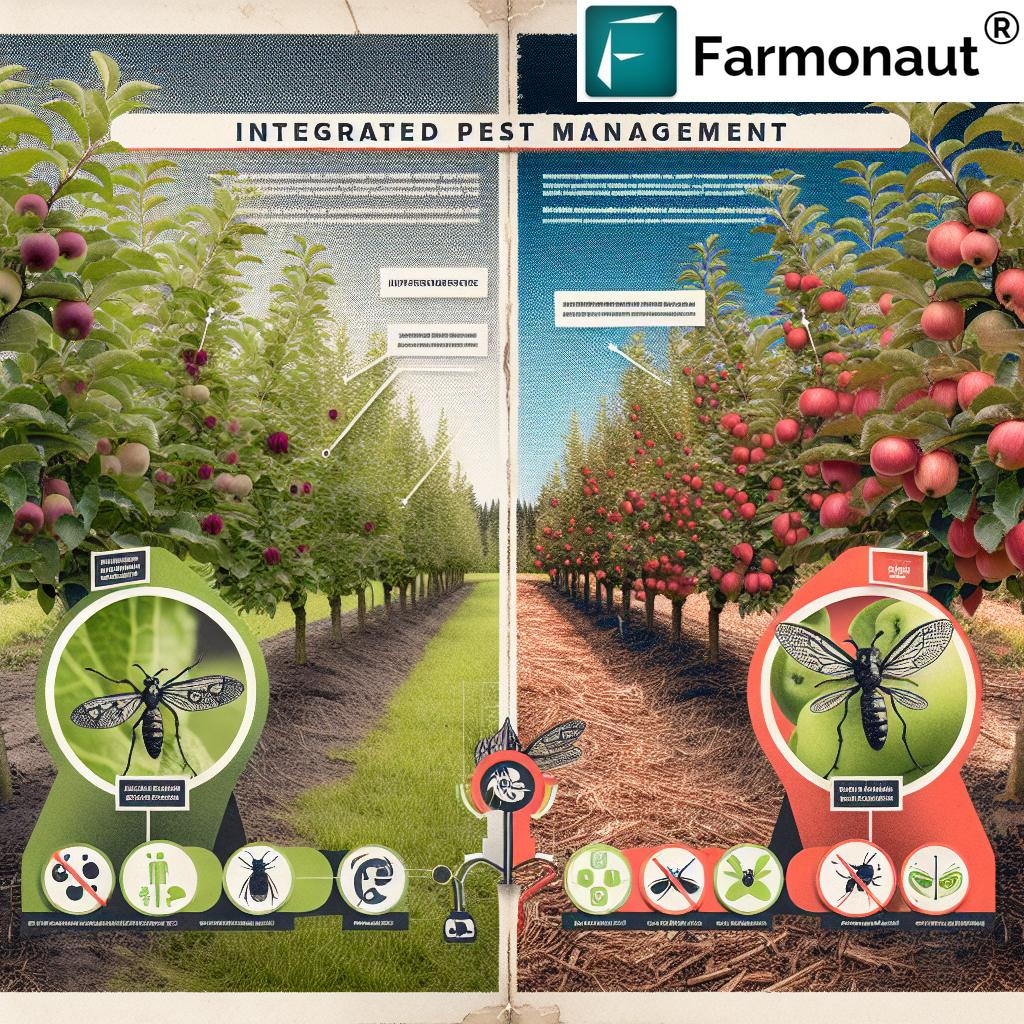Canadian Dairy Farmers: Pioneering Sustainable Agriculture for a Greener Future
Welcome to our comprehensive exploration of how Canadian dairy farmers are revolutionizing sustainable agriculture and food safety practices. In this insightful blog, we’ll delve into the innovative techniques employed in sustainable dairy farming, from regenerative agriculture to net-zero emissions goals. We’ll also examine the proAction® program, which ensures high standards in animal welfare and environmental stewardship.

“Canadian dairy farmers recycle over 25 million kilograms of agricultural plastics annually, reducing landfill waste significantly.“
The Sustainable Revolution in Canadian Dairy Farming
As we venture into the world of Canadian dairy farming, it’s crucial to understand the significant strides being made towards sustainability. Our dairy farmers are at the forefront of implementing sustainable farming techniques that not only benefit the environment but also ensure the production of high-quality, safe dairy products.
- Implementing regenerative agriculture practices
- Striving for net-zero emissions
- Enhancing soil health and biodiversity
- Adopting innovative farming technology
These practices are not just buzzwords; they represent a fundamental shift in how we approach dairy farming in Canada. Let’s explore each of these aspects in detail.
Regenerative Agriculture: A Game-Changer for Dairy Farms
Regenerative agriculture is more than just a sustainable farming technique; it’s a philosophy that aims to improve the land rather than simply sustain it. Canadian dairy farmers are increasingly adopting these practices to enhance soil health, increase biodiversity, and sequester carbon.
Some key regenerative agriculture practices include:
- Minimal tillage to preserve soil structure
- Cover cropping to prevent erosion and add nutrients
- Rotational grazing to improve pasture health
- Diversification of crops and livestock
By implementing these practices, our dairy farmers are not only producing nutritious milk but also actively contributing to the health of our planet.
The Journey Towards Net-Zero Emissions
The Canadian dairy industry has set ambitious goals to reduce its carbon footprint and move towards net-zero emissions. This commitment reflects our understanding of the urgent need to address climate change and our responsibility as stewards of the land.
Key initiatives in this journey include:
- Investing in energy-efficient equipment
- Implementing methane capture and biogas production
- Optimizing feed formulations to reduce enteric emissions
- Improving manure management practices
These efforts are not only reducing greenhouse gas emissions but also creating new opportunities for farmers to generate renewable energy and improve their operational efficiency.
Enhancing Soil Health and Biodiversity
Healthy soils are the foundation of sustainable dairy farming. Canadian dairy farmers are increasingly focusing on improving soil health through various means:
- Implementing crop rotation to maintain soil fertility
- Using cover crops to prevent erosion and add organic matter
- Reducing chemical inputs through precision agriculture
- Encouraging beneficial insects and pollinators
These practices not only improve soil health but also enhance biodiversity on dairy farms, creating a more resilient and productive ecosystem.
Innovative Farming Technology: The Future of Dairy
Technology plays a crucial role in advancing sustainable dairy farming practices. Canadian dairy farmers are leveraging cutting-edge technologies to optimize their operations and reduce their environmental impact.
Some of the innovative technologies being adopted include:
- Precision agriculture tools for efficient resource use
- Robotic milking systems for improved animal welfare
- AI-powered farm management systems
- Satellite-based crop monitoring
These technologies are helping farmers make data-driven decisions, leading to more efficient use of resources and improved sustainability outcomes.
For farmers looking to leverage satellite-based crop monitoring, Farmonaut’s web application offers advanced solutions.

The proAction® Program: Ensuring Quality and Sustainability
The proAction® program is a cornerstone of Canadian dairy farming, ensuring that our dairy products meet the highest standards of quality, safety, and sustainability. This comprehensive program covers six key areas:
- Milk Quality
- Food Safety
- Animal Care
- Livestock Traceability
- Biosecurity
- Environment
“The proAction® program ensures 100% of Canadian milk meets rigorous quality and safety standards through regular inspections.“
Through proAction®, Canadian dairy farmers demonstrate their commitment to producing milk of the highest quality while adhering to strict environmental and animal welfare standards.
Sustainable Dairy Farming Practices in Action
Let’s take a closer look at some specific sustainable practices being implemented on Canadian dairy farms:
| Sustainable Practice | Description | Environmental Impact | Adoption Rate (%) |
|---|---|---|---|
| Biodigesters | Convert manure into biogas for energy | Reduces methane emissions, produces renewable energy | 15 |
| Agricultural Plastic Recycling | Recycling of farm plastics | Reduces landfill waste, promotes circular economy | 60 |
| Cover Crops | Planting crops to cover soil between growing seasons | Improves soil health, reduces erosion | 40 |
| Rotational Grazing | Moving cattle between pastures to allow regrowth | Enhances pasture health, increases carbon sequestration | 55 |
| Net-Zero Emissions Initiatives | Comprehensive efforts to reduce carbon footprint | Reduces overall greenhouse gas emissions | 30 |
These practices demonstrate the commitment of Canadian dairy farmers to sustainable agriculture and environmental stewardship.
Canadian Milk Production: From Farm to Table
Understanding the journey of Canadian milk from farm to table is crucial in appreciating the industry’s commitment to quality and sustainability. Here’s a brief overview of the process:
- Milking: Cows are milked 2-3 times daily using advanced milking systems.
- Cooling: Milk is immediately cooled to preserve freshness.
- Quality Testing: Samples are taken for quality and safety testing.
- Transportation: Milk is transported in refrigerated tankers to processing plants.
- Processing: Milk undergoes pasteurization and may be processed into various dairy products.
- Packaging: Products are packaged using sustainable materials where possible.
- Distribution: Dairy products are distributed to retailers across Canada.
Throughout this process, strict quality control measures ensure that Canadian milk meets the highest standards of safety and nutrition.
The Role of Technology in Sustainable Dairy Farming
Technology plays a crucial role in advancing sustainable dairy farming practices. Canadian dairy farmers are increasingly adopting innovative solutions to improve efficiency and reduce their environmental impact.
For farmers interested in leveraging technology for sustainable farming, Farmonaut’s API offers advanced satellite-based solutions.
Some key technological advancements include:
- Automated milking systems
- Precision feed management
- Smart water management systems
- Satellite-based crop monitoring
- AI-powered farm management tools
These technologies not only improve farm efficiency but also contribute to reduced resource use and environmental impact.

Agricultural Plastic Recycling: A Circular Economy Approach
One of the most innovative sustainability initiatives in Canadian dairy farming is the recycling of agricultural plastics. This practice is a prime example of the industry’s commitment to reducing waste and promoting a circular economy.
Key aspects of this initiative include:
- Collection of used agricultural plastics from farms
- Processing and recycling of plastics into new products
- Reduction of plastic waste in landfills
- Creation of new economic opportunities in recycling
This initiative not only reduces the environmental impact of dairy farming but also sets an example for other agricultural sectors to follow.
Biodiversity and Dairy Farming: A Symbiotic Relationship
Canadian dairy farmers are increasingly recognizing the importance of biodiversity on their farms. By promoting diverse ecosystems, they’re not only improving the health of their land but also contributing to broader conservation efforts.
Some ways dairy farms are promoting biodiversity include:
- Creating wildlife corridors
- Maintaining wetlands and natural habitats
- Planting native species
- Reducing pesticide use
These efforts demonstrate that dairy farming can coexist with and even enhance local ecosystems.
Water Management in Dairy Farming
Efficient water management is crucial for sustainable dairy farming. Canadian dairy farmers are implementing various strategies to conserve water and protect water quality:
- Implementing water recycling systems
- Using precision irrigation techniques
- Creating buffer zones near water sources
- Proper management of manure and runoff
These practices not only conserve water but also protect local water sources from potential contamination.
The Future of Sustainable Dairy Farming in Canada
As we look to the future, the Canadian dairy industry is poised to continue its leadership in sustainable agriculture. Some key areas of focus for the coming years include:
- Further reduction of carbon emissions
- Increased adoption of renewable energy
- Development of more sustainable packaging solutions
- Continued improvement in animal welfare practices
- Enhanced traceability throughout the supply chain
These initiatives will ensure that Canadian dairy remains at the forefront of sustainable food production.
For farmers looking to leverage technology for sustainable farming, Farmonaut offers solutions on both Android and iOS platforms.


Conclusion: A Sustainable Future for Canadian Dairy
As we’ve explored throughout this blog, Canadian dairy farmers are at the forefront of sustainable agriculture, pioneering practices that benefit both the environment and consumers. From implementing regenerative agriculture techniques to adopting cutting-edge technology, the industry is committed to producing high-quality, nutritious dairy products while minimizing its environmental impact.
The proAction® program ensures that these sustainable practices are implemented consistently across the industry, maintaining high standards of animal welfare, food safety, and environmental stewardship. As consumers, we can take pride in knowing that when we choose Canadian dairy products, we’re supporting a sustainable and responsible industry.
As we look to the future, the Canadian dairy industry will continue to innovate and adapt, meeting the challenges of climate change head-on while ensuring a stable supply of nutritious dairy products for generations to come. By supporting Canadian dairy, we’re not just nourishing our bodies – we’re contributing to a greener, more sustainable future for all.
FAQs about Sustainable Dairy Farming in Canada
- What is regenerative agriculture in dairy farming?
Regenerative agriculture in dairy farming involves practices that improve soil health, increase biodiversity, and sequester carbon. This includes minimal tillage, cover cropping, and rotational grazing. - How are Canadian dairy farmers reducing their carbon footprint?
Canadian dairy farmers are reducing their carbon footprint through various means, including implementing energy-efficient equipment, using methane digesters, optimizing feed formulations, and improving manure management practices. - What is the proAction® program?
The proAction® program is a comprehensive quality assurance program that ensures Canadian dairy farms meet high standards in milk quality, food safety, animal care, traceability, biosecurity, and environmental stewardship. - How does technology contribute to sustainable dairy farming?
Technology contributes to sustainable dairy farming through precision agriculture tools, robotic milking systems, AI-powered farm management systems, and satellite-based crop monitoring, all of which improve efficiency and reduce resource use. - What is agricultural plastic recycling in dairy farming?
Agricultural plastic recycling in dairy farming involves collecting and processing used farm plastics, such as silage wrap and bale nets, into new products, reducing waste and promoting a circular economy.













